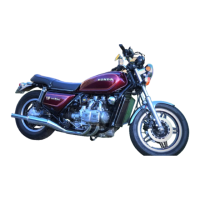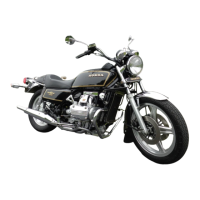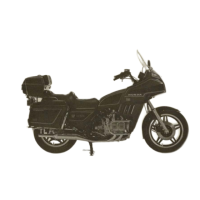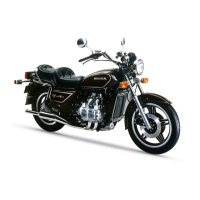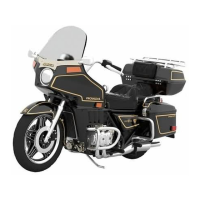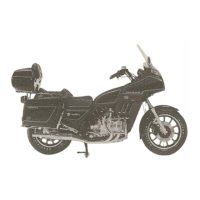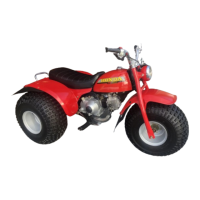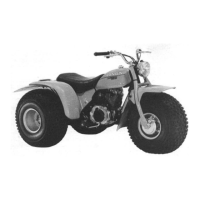Do you have a question about the Honda GL1100 1980 and is the answer not in the manual?
Essential rules for safe operation, including inspection, licensing, visibility, and obeying laws.
Recommends helmet, face shield, boots, gloves, and protective clothing.
Warns that modifications can render the vehicle unsafe or illegal.
Guidelines for safely adding and riding with accessories and cargo.
Details tire types, sizes, pressures, and brands for tubeless tires.
Covers tire inspection, tread depth, and repair/replacement procedures.
Recommends air pressures for suspension based on load and conditions.
Step-by-step guide for checking and adding air to suspension components.
Identifies various controls and components on the motorcycle.
Explains location and importance of VIN, frame, and engine serial numbers.
Describes the purpose of gauges, indicators, and warning lights.
How to read the coolant temperature gauge.
Describes the fuel gauge and reserve fuel function.
Details functions of ignition switch in different key positions.
Explains the three-position engine stop switch.
Describes the starter button's function.
Controls high and low beam selection.
Operates turn signals.
Activates the horn.
How to engage the steering lock.
Use of the helmet holder when parked.
Location and use of the top compartment.
How to adjust the seat positions.
Information on the ACC terminal for accessories.
Operation of the three-way fuel valve.
Fuel tank capacity and recommended octane.
Procedure for checking and refilling engine oil.
Specifies recommended oil type, quality, and viscosity.
Coolant type, mixture, and level checking.
Essential checks before riding.
Step-by-step guide for starting the engine.
Warm-up steps for different temperatures.
Procedure for clearing a flooded engine.
Recommendations for the initial 600 miles.
Recommended RPMs for upshifting and downshifting.
Details normal and maximum deceleration, combined brake use.
Steps for parking the motorcycle.
Tips for preventing motorcycle theft.
Procedures for handling common road issues.
Lists the tools included in the kit.
Step-by-step instructions for removing the front wheel.
Steps for reinstalling the front wheel.
Step-by-step instructions for removing the rear wheel.
Steps for reinstalling the rear wheel.
Locates fuse box and provides replacement safety.
Discusses emissions, dealer service, and DIY maintenance.
Schedule for emission-related components.
Schedule for non-emission related items.
Emphasizes completing and retaining maintenance records.
Procedure for draining, replacing filter, and refilling oil.
Procedure for replacing the oil filter element.
Lists recommended plugs and procedures for replacement.
Procedure for adjusting engine idle speed.
Steps for replacing the air cleaner element.
Procedure for emptying breather deposits.
How to adjust clutch lever free play.
Procedure for checking and refilling front brake fluid.
Procedure for checking and refilling rear brake fluid.
How to inspect brake pads for wear.
Inspecting side stand for wear and function.
Checking and adding distilled water to battery electrolyte.
Advice on regular cleaning.
Maintenance for long-term storage.
Explains emission sources and control systems.
Describes the closed crankcase system.
Lists symptoms of emission system issues.
Data on braking performance.
Data on acceleration and passing.
Lists dimensions, wheelbase, ground clearance, and weight.
Details engine bore, stroke, displacement, and spark plugs.
Covers chassis, transmission, and electrical specs.
Lists bulb types and specifications for lights.
Guidelines for resolving issues with dealer service.
| Year | 1980 |
|---|---|
| Manufacturer | Honda |
| Model | GL1100 |
| Category | Touring |
| Compression Ratio | 9.2:1 |
| Ignition | Transistorized |
| Starting System | Electric |
| Transmission | 5-speed |
| Final Drive | Shaft |
| Front Suspension | Telescopic fork |
| Front Brakes | Dual disc |
| Rear Brakes | Single disc |
| Front Tire | 3.50-19 |
| Rear Tire | 4.50-17 |
| Engine Type | Four-stroke, liquid-cooled, horizontally opposed four-cylinder |
| Rear Suspension | Air-assisted shocks |
| Dry Weight | 272 kg (600 pounds) |
| Fuel Capacity | 19 liters (5.0 gallons) |
| Seat Height | 790 mm (31.1 inches) |
